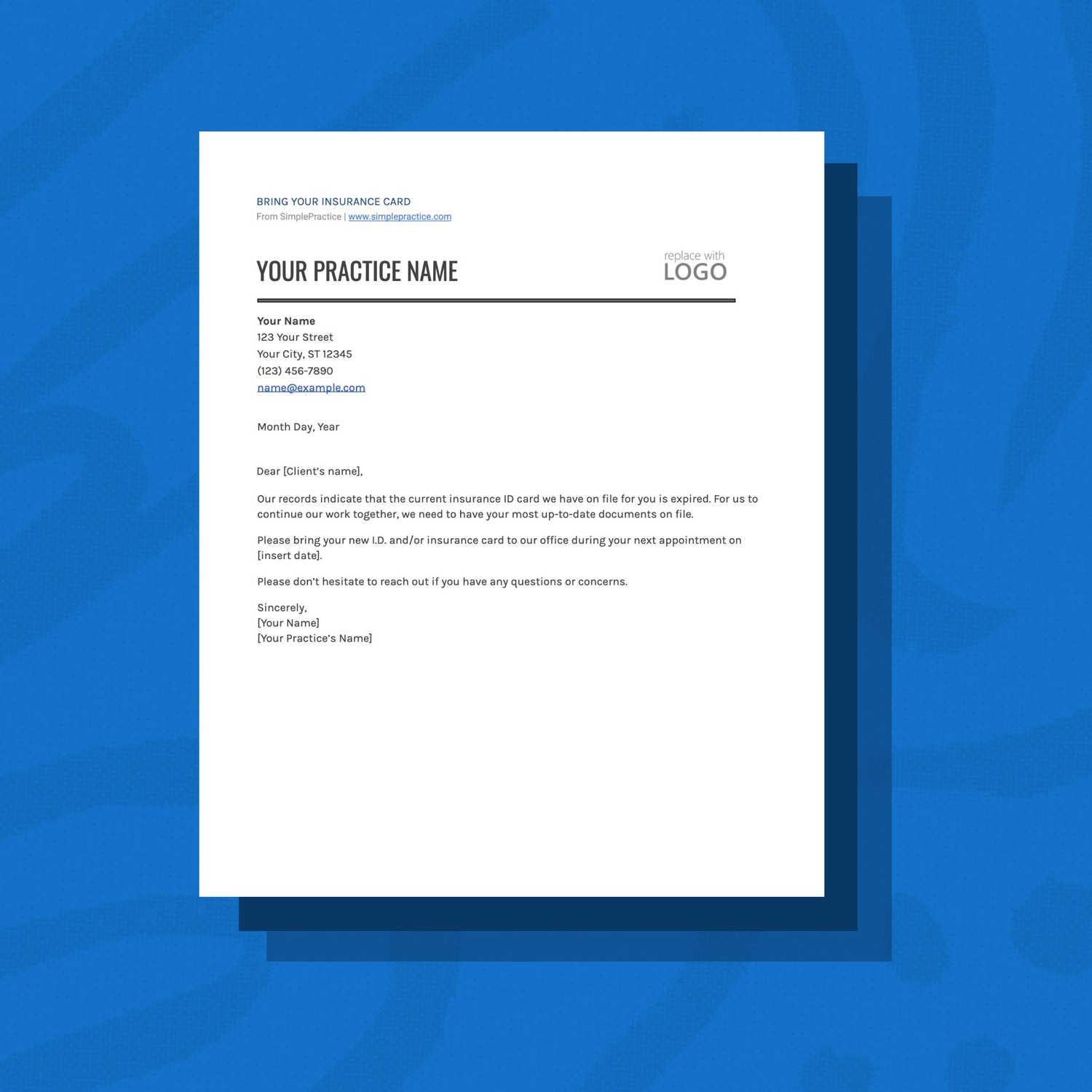Insurance Card Reminder Template
Download the free insurance card reminder template
Download free resource
Enter your email below to access this resource.
By entering your email address, you are opting-in to receive emails from SimplePractice on its various products, solutions, and/or offerings. Unsubscribe anytime.

As a therapist in private practice, you’ll want to remain on-top of your billing and practice management—one way to do this is by utilizing an insurance card reminder template to keep track of when your clients’ insurance expires.
Many behavioral health clinicians find it challenging to balance a full client caseload with the administrative burdens of practice management, like records management, dealing with insurers, and timely billing.
This is why it’s critical that clients, who use their insurance card for mental health services, keep their records up-to-date. This article provides a guide to insurance card reminders—giving context on why clients’ insurance may expire and a free downloadable insurance card reminder template to save in your electronic health record (EHR).
Reasons a client's insurance may expire
There are several reasons a client’s insurance may expire, including:
A change in employment
The client may have changed employers and service providers, or perhaps there is a qualifying period to obtain the benefit with their new employer.
Age limits
Clients may have reached the age limit to be included on their parents’ insurance. Typically, insurance plans cover dependents until their 26th birthday under the Affordable Care Act, but it depends on the state.
College students
Health insurance plans end a few months after graduation and sometimes cease mid-month, which may leave individuals without coverage.
Coverage start dates
A client may have a qualifying event to pick a plan through the Health Insurance Marketplace outside of the enrollment period. However, the Marketplace doesn’t allow coverage to begin until the first of the following month, which could leave the client without coverage until their new plan starts.
Financial difficulties
Perhaps the client has lost their job or experienced financial insecurity, and they have exceeded the grace period afforded by their insurer.
Change to relationship status
Your client may have gotten married or divorced and been added or removed from their partner’s insurance plan.
Mismanagement/extenuating circumstances
Your client could simply have forgotten to check their bank balance or miscalculated their expenses and their insurance payment bounced. This could happen for many reasons, such as going through stressful events, moving home, grief, etc.
How to verify your client's insurance
Here are steps you can take to verify your client’s health insurance coverage:
Collect health insurance information during intake
Collect the client’s health insurance information on their intake paperwork, or even prior to sending intake forms. This could save you administrative time if you find the plan doesn’t cover your services.
Gather the following information:
- Make a copy of the front and back of the insurance card for therapy, ensuring it contains their ID, Group number, plan information, and contact details of the insurer.
- Verify the primary insurance plan holder.
- Ask if the client has any secondary insurance and obtain the same information listed above.
Contact their insurance company
Contact the insurance company listed on the client’s paperwork before their first visit.
Verify the following information:
- Confirm the policy is active and verify any listed end date
- Verify the patient contact information
- Level of coverage
- Copay and coinsurance information
- Deductible
- Pre-authorization requirements, such as medical necessity verification
- Check any limitations to coverage. For example, does the client need to reach their deductible before their insurance benefits kick in?
- Ask if you are in-network or out-of-network with the provider
You could also ask your client to contact their insurance provider and check coverage for your services. This ensures they are fully aware of the level of coverage and their financial responsibilities before engaging your services.
Other ways to verify client insurance information
- As an alternative to verifying the insurance yourself, you could use an automatic verification service that may even integrate with your EHR.
- Add the information to your EHR in the billing information section.
- If you use a biller, ensure the client's information is securely communicated to the biller.
- You may want to re-verify your client’s insurance every month, especially if they experience a change in life circumstances, like divorce, marriage, or change in employment.
Sample insurance card reminder template
Ideally, your client should inform you of any changes to their insurance right away.
However, life happens, and they may forget, especially if they are experiencing a stressful period.
This is why it’s important to re-verify your client’s insurance every month to ensure they haven't had a change in coverage.
We have created a customizable insurance card reminder template to easily communicate with your clients regarding their insurance. You can customize the reminder card template and use it either as a monthly insurance card reminder template and/or as an insurance card reminder letter if their insurer has denied a claim due to lapsed coverage.
If you’re looking for an insurance card reminder template, you may find the following sample paragraph examples helpful:
Reverification sample paragraph
“As part of our monthly practice management, I/we check-in with all clients to ensure your records are up-to-date. Life happens and we can forget to update critical information. By regularly reviewing client records, I/we avoid any unnecessary paperwork, such as dealing with returned claim forms or delays in coordination of care. To assist this process, I/we ask that you take a moment to check your records in the client portal [include link], ensuring your address and insurance information is accurate. This can be accessed by [insert relevant links/details of where to find their address and insurance page in their client record].”
Lapsed insurance sample paragraph
“Our records indicate that the insurance ID information we have on file has expired. We were notified by [insert insurers name] on [date of their communication] that your insurance will expire on [date of expiration] due to [insert any relevant reasons or information the insurer provided]. For us to continue our work together, we need to have your most up-to-date payment methods and corresponding documents on file.”
Sample paragraph on how clients can update their information
“Please bring your new ID and/or insurance card to our office during your next appointment on [insert date], or update your billing and insurance information in the client portal [delete as necessary]. You can access your client record by [insert relevant links/details of where to find their address and insurance page in their client record].”
How SimplePractice streamlines running your practice
SimplePractice is HIPAA-compliant practice management software with everything you need to run your practice built into the platform—from booking and scheduling to insurance and client billing.
If you’ve been considering switching to an EHR system, SimplePractice empowers you to streamline appointment bookings, reminders, and rescheduling and simplify the billing and coding process—so you get more time for the things that matter most to you.
Try SimplePractice free for 30 days. No credit card required.

